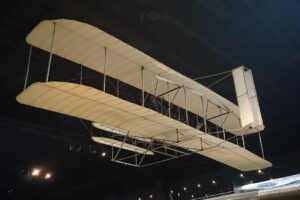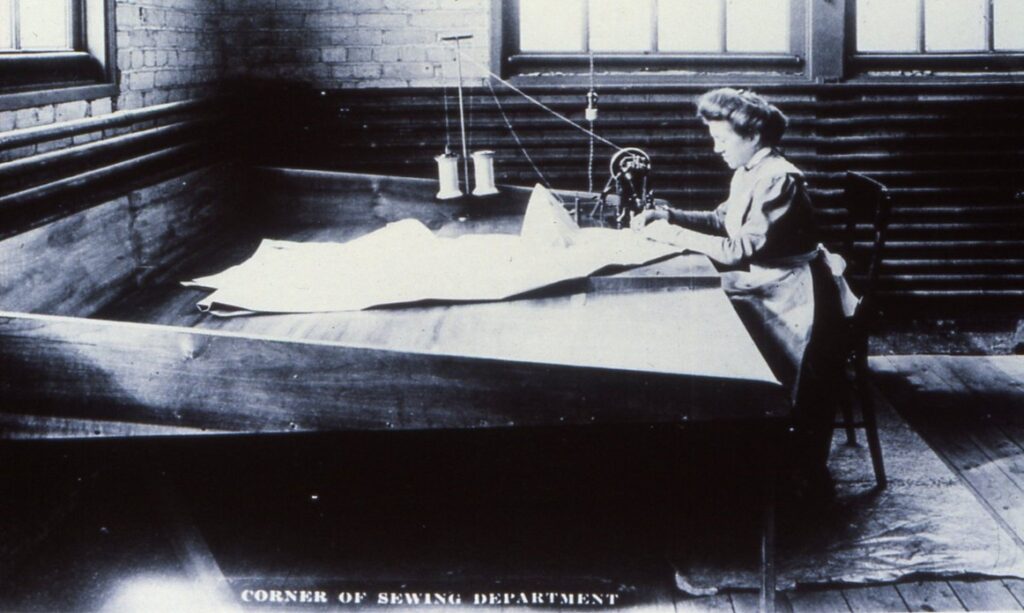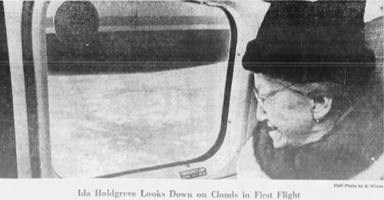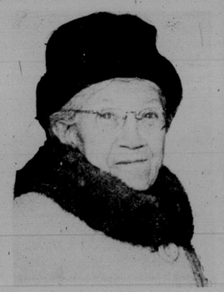Under-Told Stories: Ida Holdgreve – “Rosie the Riveter” Before Planes Had Rivets
By Haley Martin, M.A. – Public historian and America 250-Ohio Project Coordinator for Trails & Tales and the 250 Buckeye Train & Transportation Celebration.

Ida Holdgreve, known as “America’s first female aerospace worker,” answered a Dayton newspaper ad in 1910 calling for a “plain” sewer. Ida, an accomplished seamstress, had moved to Dayton two years prior and was looking for work, so she applied for the job, and she quickly learned she got the job! However, she also quickly learned that the job was actually for a “plane” sewer. Since aviation was a new industry, the newspaper assumed there had been a misspelling in the ad and edited the word “plane.” Suddenly, Ida found herself as the head seamstress at the Wright Brothers Airplane Factory.
Wright Brothers Airplane Factory
Ida Holdgreve grew up in Delphos, Ohio as one of nine children and moved to Dayton, Ohio at the age of 27, bringing with her valuable dressmaking skills. When she was hired by Orville and Wilbur Wright to sew for their planes, Ida trained with Duval La Chapelle, Wilbur’s mechanic from France. He showed Ida how to stretch the fabric used to build the planes without ripping the plane’s fragile frame.
With her newfound skills taught by La Chapelle, she began working “in a little room in Edgemont,” as the new company was working out of a small unused part of the Speedwell Motor Car Company plant. Once the Wright Brothers Airplane Factory was completed, Ida moved to the factory floor, as the only woman.
She remained the only woman to work on the factory floor through the company’s existence. For $8-10 a week, she fed her large sewing machine two spools of thread, sewing cream-colored fabric into airplane wings, fins, rudders, and stabilizers.

She and her coworkers were the first Americans hired and trained for specialized aircraft manufacturing jobs, and they manufactured around 120 planes for 13 different models from 1910-1915.
Ida particularly enjoyed working at the factory since it was located three miles outside of Dayton, surrounded by cornfields. While she liked the booming city of Dayton, the cornfields reminded her of her hometown Delphos, where she had grown up. She also enjoyed working with Orville and Wilbur, recalling “both boys were quiet… but they were both nice.”
Dayton-Wright Airplane Company

When Wilbur Wright unexpectedly died of typhoid fever in 1912, Orville lost the determination to continue the company. Instead, he sold the business and joined the Dayton-Wright Airplane Company. Ida followed Orville to the new business, where she served as forewoman for a group of young seamstresses during World War I. For her work building planes for the war efforts, she has recently been called “Rosie the Riveter before there were airplane rivets” by historians. Following the war, Ida retired from plane sewing, getting a job sewing at the Rike-Kumler department store in Dayton. She continued working as a seamstress until she retired at age 71.
Ida’s First Flight at age 88

In November 1969, Ida Holdgreve, at age 88, took her first flight. She had never flown while working with airplanes, and the Dayton Area Chamber of Commerce set out to change that. Ida’s flight gained national attention, much to her surprise. “You know, I didn’t think they would make such a big deal out of it. I just wanted to fly,” Ida said when asked about her thoughts on her sudden celebrity status. The flight path took Ida sailing over the Wright Company in West Dayton. Following her flight, Ida recalled that it was quite difficult to hear in the air, which she didn’t like, but that “the clouds look just like wool,” a statement fitting for a seamstress. Apparently, the view made up for the noise, as Ida stated that she very much enjoyed the flight.
Ida’s Legacy

Ida Holdgreve passed away at age 95 while visiting family in Delphos, but her legacy was set in aviation history. The tradition of seamstresses working in aviation started with Ida but continued long after she retired from the industry. Even today, seamstresses are an important part of aviation. While planes are no longer hand-sewn, having functional and comfortable clothing is essential to pilots, engineers, and flight attendants. The Air Force Life Cycle Management Center Uniform Office in Dayton works today to continue evolving uniforms. Their current project is creating maternity clothing for aviation workers.
The Wright Factory Families project helped bring Ida’s story to light, and they are hoping to continue sharing the stories of those who worked at the Wright Company. The desire for these stories is because “it makes people come alive,” which helps bring the history of the Wright Company to life. The National Parks Service hopes to one day open the Wright Company building to share the story of all the workers and the history that occurred in the building, which will, of course, feature Ida.
Trails & Tales: The Ohio Air & Space Trail
Learn more about Ida Holdgreve’s story on the Ohio Air & Space Trail. This trail shares the history of aviation and aerospace across the state of Ohio. From the Wright Brothers to Neil Armstrong to the history of planes and materials, Ohio has been a central force in the United States’ success in aviation and space feats. Follow in the footsteps (or flight paths) of pioneer aviators, innovators and explorers who helped the world take flight. Explore 40 museums and historic sites to learn more about Ohio’s contribution to aviation and aerospace. Ida’s story is featured at the Delphos Canal Commission Museum.
About the Author:
Haley Martin, M.A.
Haley Martin is a public historian currently working on two of America 250-Ohio’s Signature Events: Trails & Tales and 250 Buckeye Train & Transportation Celebration. She earned her Master of Arts in Public History from West Virginia University in 2024 and her Bachelor of Arts in History from Heidelberg University (Ohio) in 2022. Her main research areas include women’s history, revolutionary America, public history, and theater history. In her free time, Haley enjoys performing music, planning vacations for family and friends, reading, and watching Disney movies.
Article Sources:
Allyson Crawford, “Meet the first woman in the aviation industry,” Wright-Patterson AFB, March 23, 2021, https://www.wpafb.af.mil/News/Article-Display/Article/2548397/meet-the-first-woman-in-the-aviation-industry/.
Bob Ebbeskotte, “Plane Sewing,” Banks of Yesterday – Delphos Canal Commission, January 6, 2022, https://delphoscanalcommission.com/banks-yesteryear/plane-sewing/.
“A Forgotten Life,” OhioTraveler, https://www.ohiotraveler.com/a-forgotten-life/.
Leo Deluca, “How Ida Holdgreve’s Stitches Helped the Wright Brothers Get Off the Ground,” Smithsonian Magazine, March 15, 2021, https://www.smithsonianmag.com/history/how-ida-holdgreves-stitches-helped-wright-brothers-get-off-ground-180977195/.
Leo Deluca, “Ida Holdgreve: The Plane Sewer,” Dayton Magazine, April 17, 2024, https://www.thedaytonmagazine.com/ida-holdgreve-the-plain-sewer/.
Photo Credits:
Wright Brothers Plane Photograph by Michael Barera, CC BY-SA 4.0, https://commons.wikimedia.org/w/index.php?curid=85422272
Photographs of Ida Hardgreve provided by Bob Ebbskotte of the Delphos Canal Commission Museum.